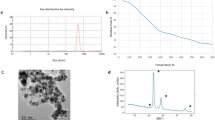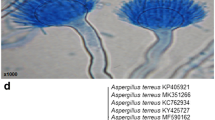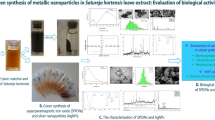Abstract
Despite the potent antimicrobial activity of magnetite nanoparticles (MtNPs), research on the antifungal activity of MtNP against filamentous fungi is rare. In this study, MtNP was synthesized by an inexpensive and easy green approach using the aqueous extract of Ananas comosus (pineapple) peels (AP), and applied as an antifungal agent against the filamentous fungal pathogens Fusarium verticilliodes, Aspergillus flavus, and Alternaria alternata (CGJM3078 and CGJM3006). The AP-mediated MtNP (AP-MtNP) was characterized by the XRD, UV-Visible, FTIR, BET, TGA, SEM, TEM, and EDX techniques. These characterizations revealed the successful synthesis of AP-MtNP by the reducing and stabilizing action of the aqueous extract of AP. The BET analysis showed a high surface area of 233.8 m2/g, while high thermal stability of AP-MtNP was displayed by the TGA. The SEM and TEM images mostly showed spherical AP-MtNPs with an average size of 17.87 nm and a somewhat dispersed and porous surface morphology. The newly synthesized AP-MtNPs exhibited effective antifungal activity against the four fungal strains.








Similar content being viewed by others
References
Pillai AM, Sivasankarapillai VS, Rahdar A, Joseph J, Sadeghfar F, Anuf A R, Rajesh K, Kyzas GZ (2020) Green synthesis and characterization of zinc oxide nanoparticles with antibacterial and antifungal activity. J Mol Struct 1211:128107. https://doi.org/10.1016/j.molstruc.2020.128107
Kathiravan V, Ravi S, Ashokkumar S, Velmurugan S, Elumalai K, Khatiwada CP (2015) Green synthesis of silver nanoparticles using Croton sparsiflorus morong leaf extract and their antibacterial and antifungal activities. Spectrochim Acta A Mol Biomol Spectrosc 139:200–205. https://doi.org/10.1016/j.saa.2014.12.022
Jebril S, Khanfir Ben Jenana R, Dridi C (2020) Green synthesis of silver nanoparticles using Melia azedarach leaf extract and their antifungal activities: In vitro and in vivo. Mater Chem Phys 248:122898. https://doi.org/10.1016/j.matchemphys.2020.122898
Mahdavi B, Saneei S, Qorbani M et al (2019) Ziziphora clinopodioides Lam leaves aqueous extract mediated synthesis of zinc nanoparticles and their antibacterial, antifungal, cytotoxicity, antioxidant, and cutaneous wound healing properties under in vitro and in vivo conditions. Appl Organomet Chem 33. https://doi.org/10.1002/aoc.5164
Pethakamsetty L, Kothapenta K, Nammi HR, Ruddaraju LK, Kollu P, Yoon SG, Pammi SVN (2017) Green synthesis, characterization and antimicrobial activity of silver nanoparticles using methanolic root extracts of Diospyros sylvatica. J Environ Sci 55:157–163. https://doi.org/10.1016/j.jes.2016.04.027
López-Miranda JL, Vázquez M, Fletes N, Esparza R, Rosas G (2016) Biosynthesis of silver nanoparticles using a Tamarix gallica leaf extract and their antibacterial activity. Mater Lett 176:285–289. https://doi.org/10.1016/j.matlet.2016.04.126
Gao Y, Xu D, Ren D, Zeng K, Wu X (2020) Green synthesis of zinc oxide nanoparticles using Citrus sinensis peel extract and application to strawberry preservation: a comparison study. LWT 126:109297. https://doi.org/10.1016/j.lwt.2020.109297
Etemadifar R, Kianvash A, Arsalani N, Abouzari-Lotf E, Hajalilou A (2018) Green synthesis of superparamagnetic magnetite nanoparticles: effect of natural surfactant and heat treatment on the magnetic properties. J Mater Sci Mater Electron 29:17144–17153. https://doi.org/10.1007/s10854-018-9805-6
Akpomie KG, Conradie J (2020) Biosorption and regeneration potentials of magnetite nanoparticle loaded Solanum tuberosum peel for celestine blue dye. Int J Phytoremediation:1–15. https://doi.org/10.1080/15226514.2020.1814198
Ali A, Zafar H, Zia M, ul Haq I, Phull AR, Ali JS, Hussain A (2016) Synthesis, characterization, applications, and challenges of iron oxide nanoparticles. Nanotechnol Sci Appl 9:49–67. https://doi.org/10.2147/NSA.S99986
El-Dib FI, Mohamed DE, El-Shamy OAA, Mishrif MR (2020) Study the adsorption properties of magnetite nanoparticles in the presence of different synthesized surfactants for heavy metal ions removal. Egypt J Pet 29:1–7. https://doi.org/10.1016/j.ejpe.2019.08.004
Germanos G, Youssef S, Farah W et al (2020) The impact of magnetite nanoparticles on the physicochemical and adsorption properties of magnetic alginate beads. J Environ Chem Eng 8:104223. https://doi.org/10.1016/j.jece.2020.104223
Stoimenov PK, Klinger RL, Marchin GL, Klabunde KJ (2002) Metal oxide nanoparticles as bactericidal agents. Langmuir 18:6679–6686. https://doi.org/10.1021/la0202374
Prabhu YT, Rao KV, Kumari BS, Kumar VSS, Pavani T (2015) Synthesis of Fe3O4 nanoparticles and its antibacterial application. Int Nano Lett 5:85–92. https://doi.org/10.1007/s40089-015-0141-z
Taimoory SM, Rahdar A, Aliahmad M, Sadeghfar F, Hajinezhad MR, Jahantigh M, Shahbazi P, Trant JF (2018) The synthesis and characterization of a magnetite nanoparticle with potent antibacterial activity and low mammalian toxicity. J Mol Liq 265:96–104. https://doi.org/10.1016/j.molliq.2018.05.105
Salem MA, Elsharkawy RG, Ayad MI, Elgendy MY (2019) Silver nanoparticles deposition on silica, magnetite, and alumina surfaces for effective removal of Allura red from aqueous solutions. J Sol-Gel Sci Technol 91:523–538. https://doi.org/10.1007/s10971-019-05055-7
Patra JK, Baek K-H (2017) Green biosynthesis of magnetic iron oxide (Fe 3 O 4 ) nanoparticles using the aqueous extracts of food processing wastes under photo-catalyzed condition and investigation of their antimicrobial and antioxidant activity. J Photochem Photobiol B Biol 173:291–300. https://doi.org/10.1016/j.jphotobiol.2017.05.045
Arakha M, Pal S, Samantarrai D, Panigrahi TK, Mallick BC, Pramanik K, Mallick B, Jha S (2015) Antimicrobial activity of iron oxide nanoparticle upon modulation of nanoparticle-bacteria interface. Sci Rep 5:14813. https://doi.org/10.1038/srep14813
Yew YP, Shameli K, Miyake M, Kuwano N, Bt Ahmad Khairudin NB, Bt Mohamad SE, Lee KX (2016) Green synthesis of magnetite (Fe3O4) nanoparticles using seaweed (Kappaphycus alvarezii) extract. Nanoscale Res Lett 11:276. https://doi.org/10.1186/s11671-016-1498-2
Sato J, Kobayashi M, Kato H, Miyazaki T, Kakihana M (2014) Hydrothermal synthesis of magnetite particles with uncommon crystal facets. J Asian Ceram Soc 2:258–262. https://doi.org/10.1016/j.jascer.2014.05.008
Salem DMSA, Ismail MM, Aly-Eldeen MA (2019) Biogenic synthesis and antimicrobial potency of iron oxide (Fe3O4) nanoparticles using algae harvested from the Mediterranean Sea, Egypt. Egypt J Aquat Res 45:197–204. https://doi.org/10.1016/j.ejar.2019.07.002
Gopinath V, MubarakAli D, Priyadarshini S, Priyadharsshini NM, Thajuddin N, Velusamy P (2012) Biosynthesis of silver nanoparticles from Tribulus terrestris and its antimicrobial activity: a novel biological approach. Colloids Surf B: Biointerfaces 96:69–74. https://doi.org/10.1016/j.colsurfb.2012.03.023
Ramesh AV, Rama Devi D, Mohan Botsa S, Basavaiah K (2018) Facile green synthesis of Fe 3 O 4 nanoparticles using aqueous leaf extract of Zanthoxylum armatum DC. for efficient adsorption of methylene blue. J Asian Ceram Soc 6:145–155. https://doi.org/10.1080/21870764.2018.1459335
Giti Emtiazi NG (2015) The influence of Microbacterium hominis and Bacillus licheniformis extracellular polymers on silver and iron oxide nanoparticles production; green biosynthesis and mechanism of bacterial nano production. J Nanomater Mol Nanotechnol 04. https://doi.org/10.4172/2324-8777.1000160
Ghojavand S, Madani M, Karimi J (2020) Green synthesis, characterization and antifungal activity of silver nanoparticles using stems and flowers of felty germander. J Inorg Organomet Polym Mater 30:2987–2997. https://doi.org/10.1007/s10904-020-01449-1
Guo T, Yao M-S, Lin Y-H, Nan C-W (2015) A comprehensive review on synthesis methods for transition-metal oxide nanostructures. CrystEngComm 17:3551–3585. https://doi.org/10.1039/C5CE00034C
Haddad P, Seabra AB, Duran N (2013) Biogenic synthesis of nanostructured iron compounds: applications and perspectives. IET Nanobiotechnol 7:90–99. https://doi.org/10.1049/iet-nbt.2012.0047
Shah M, Fawcett D, Sharma S, Tripathy S, Poinern G (2015) Green synthesis of metallic nanoparticles via biological entities. Materials (Basel) 8:7278–7308. https://doi.org/10.3390/ma8115377
Yew YP, Shameli K, Miyake M, Ahmad Khairudin NBB, Mohamad SEB, Naiki T, Lee KX (2020) Green biosynthesis of superparamagnetic magnetite Fe3O4 nanoparticles and biomedical applications in targeted anticancer drug delivery system: A review. Arab J Chem 13:2287–2308. https://doi.org/10.1016/j.arabjc.2018.04.013
Jamzad M, Kamari Bidkorpeh M (2020) Green synthesis of iron oxide nanoparticles by the aqueous extract of Laurus nobilis L. leaves and evaluation of the antimicrobial activity. J Nanostruct Chem 10:193–201. https://doi.org/10.1007/s40097-020-00341-1
Cai Y, Shen Y, Xie A, Li S, Wang X (2010) Green synthesis of soya bean sprouts-mediated superparamagnetic Fe3O4 nanoparticles. J Magn Magn Mater 322:2938–2943. https://doi.org/10.1016/j.jmmm.2010.05.009
Akpomie KG, Conradie J (2021) Ultrasonic aided sorption of oil from oil-in-water emulsion onto oleophilic natural organic-silver nanocomposite. Chem Eng Res Des 165:12–24. https://doi.org/10.1016/j.cherd.2020.10.019
Hajar N, Zainal S, Nadzirah KZ, Roha AMS, Atikah O, Elida TZMT (2012) Physicochemical properties analysis of three indexes pineapple (Ananas Comosus) peel extract variety N36. APCBEE Procedia 4:115–121. https://doi.org/10.1016/j.apcbee.2012.11.020
Upadhyay A, Lama JP, Tawata S (2013) Utilization of pineapple waste: a review. J Food Sci Technol Nepal 6:10–18. https://doi.org/10.3126/jfstn.v6i0.8255
Erukainure OL, Ajiboye JA, Okafor OY, Okoro EE, Asieba G, Sarumi BB, Adenekan SO, Zaruwa MZ (2017) Alcoholic lung injury: pineapple peel extract modulates antioxidant enzymes and attenuates lipid peroxidation in rat models. Clin Phytoscience 2:14. https://doi.org/10.1186/s40816-016-0026-3
Poadang S, Yongvanich N, Phongtongpasuk S (2017) Synthesis, characterization, and antibacterial properties of silver nanoparticles prepared from aqueous peel extract of pineapple, ananas comosus. Chiang Mai Univ J Nat Sci 16. https://doi.org/10.12982/cmujns.2017.0010
Das G, Patra JK, Debnath T et al (2019) Investigation of antioxidant, antibacterial, antidiabetic, and cytotoxicity potential of silver nanoparticles synthesized using the outer peel extract of Ananas comosus (L.). PLoS One 14:e0220950. https://doi.org/10.1371/journal.pone.0220950
Hassan Basri H, Talib RA, Sukor R, Othman SH, Ariffin H (2020) Effect of synthesis temperature on the size of ZnO nanoparticles derived from pineapple peel extract and antibacterial activity of ZnO–starch nanocomposite films. Nanomaterials 10:1061. https://doi.org/10.3390/nano10061061
Reddy MVB, Angers P, Castaigne F, Arul J (2000) Chitosan effects on blackmold rot and pathogenic factors produced by alternaria alternata in postharvest tomatoes. J Am Soc Hortic Sci 125:742–747. https://doi.org/10.21273/JASHS.125.6.742
Janse van Rensburg B, Mc Laren NW, Schoeman A, Flett BC (2016) The effects of cultivar and prophylactic fungicide spray for leaf diseases on colonisation of maize ears by fumonisin producing Fusarium spp. and fumonisin synthesis in South Africa. Crop Prot 79:56–63. https://doi.org/10.1016/j.cropro.2015.10.009
Marathe K, Naik J, Maheshwari V (2020) Biogenic synthesis of silver nanoparticles using Streptomyces spp. and their antifungal activity against Fusarium verticillioides. J Clust Sci. https://doi.org/10.1007/s10876-020-01894-5
Parveen S, Wani AH, Shah MA, Devi HS, Bhat MY, Koka JA (2018) Preparation, characterization and antifungal activity of iron oxide nanoparticles. Microb Pathog 115:287–292. https://doi.org/10.1016/j.micpath.2017.12.068
Rahdar A, Beyzaei H, Saadat M, Yu X, Trant JF (2020) Synthesis, physical characterization, and antifungal and antibacterial activities of oleic acid capped nanomagnetite and cobalt-doped nanomagnetite. Can J Chem 98:34–39. https://doi.org/10.1139/cjc-2019-0268
Camardo Leggieri M, Giorni P, Pietri A, Battilani P (2019) Aspergillus flavus and Fusarium verticillioides interaction: modeling the impact on mycotoxin production. Front Microbiol 10. https://doi.org/10.3389/fmicb.2019.02653
Lagopodi AL, Thanassoulopoulos CC (1998) Effect of a leaf spot disease caused by Alternaria alternata on Yield of Sunflower in Greece. Plant Dis 82:41–44. https://doi.org/10.1094/PDIS.1998.82.1.41
Rashid H, Mansoor MA, Haider B, Nasir R, Abd Hamid SB, Abdulrahman A (2020) Synthesis and characterization of magnetite nano particles with high selectivity using in-situ precipitation method. Sep Sci Technol 55:1207–1215. https://doi.org/10.1080/01496395.2019.1585876
Ghosh S, Paine E, Wall R, Kam G, Lauriente T, Sa-ngarmangkang PC, Horne D, Cheeptham N (2017) In situ cultured bacterial diversity from Iron Curtain Cave, Chilliwack, British Columbia, Canada. Diversity 9:36. https://doi.org/10.3390/d9030036
Kumar P, Mathpal MC, Inwati GK et al (2020) Optical and surface properties of Zn doped CdO nanorods and antimicrobial applications. Colloids Surf A Physicochem Eng Asp 605:125369. https://doi.org/10.1016/j.colsurfa.2020.125369
Beal J, Farny NG, Haddock-Angelli T et al (2020) Robust estimation of bacterial cell count from optical density. Commun Biol 3:512. https://doi.org/10.1038/s42003-020-01127-5
Stevenson K, McVey AF, Clark IBN et al (2016) General calibration of microbial growth in microplate readers. Sci Rep 6:38828. https://doi.org/10.1038/srep38828
Zakhartsev M, Reuss M (2018) Cell size and morphological properties of yeast Saccharomyces cerevisiae in relation to growth temperature. FEMS Yeast Res 18. https://doi.org/10.1093/femsyr/foy052
Ezekoye OM, Akpomie KG, Eze SI, Chukwujindu CN, Ani JU, Ujam OT (2020) Biosorptive interaction of alkaline modified Dialium guineense seed powders with ciprofloxacin in contaminated solution: central composite, kinetics, isotherm, thermodynamics, and desorption. Int J Phytoremediation 22:1028–1037. https://doi.org/10.1080/15226514.2020.1725869
Akpomie KG, Conradie J (2020) Efficient synthesis of magnetic nanoparticle-Musa acuminata peel composite for the adsorption of anionic dye. Arab J Chem 13:7115–7131. https://doi.org/10.1016/j.arabjc.2020.07.017
Chukwuemeka-Okorie HO, Ekemezie PN, Akpomie KG, Olikagu CS (2018) Calcined corncob-kaolinite Combo as new sorbent for sequestration of toxic metal ions from polluted aqua media and desorption. Front Chem 6:1–13. https://doi.org/10.3389/fchem.2018.00273
Din MI, Jabbar S, Najeeb J, Khalid R, Ghaffar T, Arshad M, Khan SA, Ali S (2020) Green synthesis of zinc ferrite nanoparticles for photocatalysis of methylene blue. Int J Phytoremediation 22:1440–1447. https://doi.org/10.1080/15226514.2020.1781783
Kamath V, Chandra P, Jeppu GP (2020) Comparative study of using five different leaf extracts in the green synthesis of iron oxide nanoparticles for removal of arsenic from water. Int J Phytoremediation 22:1278–1294. https://doi.org/10.1080/15226514.2020.1765139
Azizi A (2020) Green synthesis of Fe3O4 nanoparticles and its application in preparation of Fe3O4/cellulose magnetic nanocomposite: a suitable proposal for drug delivery systems. J Inorg Organomet Polym Mater 30:3552–3561. https://doi.org/10.1007/s10904-020-01500-1
Rajput S, Pittman CU, Mohan D (2016) Magnetic magnetite (Fe3O4) nanoparticle synthesis and applications for lead (Pb2+) and chromium (Cr6+) removal from water. J Colloid Interface Sci 468:334–346. https://doi.org/10.1016/j.jcis.2015.12.008
Ganji P (2020) Synthesis and catalytic performance of SnxSTA by microwave-assisted hydrothermal synthesis for fructose to HMF. Biomass Convers Biorefinery 10:823–830. https://doi.org/10.1007/s13399-019-00554-7
Hajalilou A, Hashim M, Ebrahimi-Kahizsangi R, Ismail I, Sarami N (2014) Synthesis of titanium carbide and TiC–SiO2 nanocomposite powder using rutile and Si by mechanically activated sintering. Adv Powder Technol 25:1094–1102. https://doi.org/10.1016/j.apt.2014.02.008
Basavegowda N, Somai Magar KB, Mishra K, Lee YR (2014) Green fabrication of ferromagnetic Fe 3 O 4 nanoparticles and their novel catalytic applications for the synthesis of biologically interesting benzoxazinone and benzthioxazinone derivatives. New J Chem 38:5415–5420. https://doi.org/10.1039/C4NJ01155D
Basavegowda N, Mishra K, Lee YR (2014) Sonochemically synthesized ferromagnetic Fe 3 O 4 nanoparticles as a recyclable catalyst for the preparation of pyrrolo[3,4-c]quinoline-1,3-dione derivatives. RSC Adv 4:61660–61666. https://doi.org/10.1039/C4RA11623B
Njagi EC, Huang H, Stafford L, Genuino H, Galindo HM, Collins JB, Hoag GE, Suib SL (2011) Biosynthesis of iron and silver nanoparticles at room temperature using aqueous Sorghum bran extracts. Langmuir 27:264–271. https://doi.org/10.1021/la103190n
Cychosz KA, Thommes M (2018) Progress in the physisorption characterization of nanoporous gas storage materials. Engineering 4:559–566. https://doi.org/10.1016/j.eng.2018.06.001
Giraldo L, Erto A, Moreno-Piraján JC (2013) Magnetite nanoparticles for removal of heavy metals from aqueous solutions: synthesis and characterization. Adsorption 19:465–474. https://doi.org/10.1007/s10450-012-9468-1
Hou L, Liang Q, Wang F (2020) Mechanisms that control the adsorption–desorption behavior of phosphate on magnetite nanoparticles: the role of particle size and surface chemistry characteristics. RSC Adv 10:2378–2388. https://doi.org/10.1039/C9RA08517C
Patra JK, Ali MS, Oh I-G, Baek K-H (2017) Proteasome inhibitory, antioxidant, and synergistic antibacterial and anticandidal activity of green biosynthesized magnetic Fe 3 O 4 nanoparticles using the aqueous extract of corn ( Zea mays L.) ear leaves. Artif Cells Nanomed Biotechnol 45:349–356. https://doi.org/10.3109/21691401.2016.1153484
Venkateswarlu S, Yoon M (2015) Surfactant-free green synthesis of Fe 3 O 4 nanoparticles capped with 3,4-dihydroxyphenethylcarbamodithioate: stable recyclable magnetic nanoparticles for the rapid and efficient removal of Hg( ii ) ions from water. Dalton Trans 44:18427–18437. https://doi.org/10.1039/C5DT03155A
Gawande MB, Rathi AK, Nogueira ID, Varma RS, Branco PS (2013) Magnetite-supported sulfonic acid: a retrievable nanocatalyst for the Ritter reaction and multicomponent reactions. Green Chem 15:1895. https://doi.org/10.1039/c3gc40457a
Bali Ogholbeyg A, Kianvash A, Hajalilou A, Abouzari-Lotf E, Zarebkohan A (2018) Cytotoxicity characteristics of green assisted-synthesized superparamagnetic maghemite (γ-Fe2O3) nanoparticles. J Mater Sci Mater Electron 29:12135–12143. https://doi.org/10.1007/s10854-018-9321-8
Akhtar S, Ismail T, Fraternale D, Sestili P (2015) Pomegranate peel and peel extracts: chemistry and food features. Food Chem 174:417–425. https://doi.org/10.1016/j.foodchem.2014.11.035
Varier KM, Gudeppu M, Chinnasamy A, et al (2019) Nanoparticles: antimicrobial applications and its prospects, Advanced Nanostructured Materials for Environmental Remediation, Environmental Chemistry for a Sustainable World, Vol 25, pp 321–355
Mattei AS, Madrid IM, Santin R, Schuch LFD, Meireles MCA (2013) In vitro activity of disinfectants against Aspergillus spp. Braz J Microbiol 44:481–484. https://doi.org/10.1590/S1517-83822013000200024
Garibo D, Borbón-Nuñez HA, de León JND, García Mendoza E, Estrada I, Toledano-Magaña Y, Tiznado H, Ovalle-Marroquin M, Soto-Ramos AG, Blanco A, Rodríguez JA, Romo OA, Chávez-Almazán LA, Susarrey-Arce A (2020) Green synthesis of silver nanoparticles using Lysiloma acapulcensis exhibit high-antimicrobial activity. Sci Rep 10:12805. https://doi.org/10.1038/s41598-020-69606-7
Singh A, Gautam PK, Verma A, Singh V, Shivapriya PM, Shivalkar S, Sahoo AK, Samanta SK (2020) Green synthesis of metallic nanoparticles as effective alternatives to treat antibiotics resistant bacterial infections: a review. Biotechnol Rep 25:e00427. https://doi.org/10.1016/j.btre.2020.e00427
Rodrigues ML (2018) The multifunctional fungal ergosterol. MBio 9. https://doi.org/10.1128/mBio.01755-18
Wang L, Hu C, Shao L (2017) The antimicrobial activity of nanoparticles: present situation and prospects for the future. Int J Nanomedicine 12:1227–1249. https://doi.org/10.2147/IJN.S121956
Amro NA, Kotra LP, Wadu-Mesthrige K, Bulychev A, Mobashery S, Liu GY (2000) High-resolution atomic force microscopy studies of the Escherichia coli outer membrane: structural basis for permeability. Langmuir 16:2789–2796. https://doi.org/10.1021/la991013x
Kim SW, Kim KS, Lamsal K, Kim YJ, Kim SB, Jung M, Sim SJ, Kim HS, Chang SJ, Kim JK, Lee YS (2009) An in vitro study of the antifungal effect of silver nanoparticles on oak wilt pathogen Raffaelea sp. J Microbiol Biotechnol 19:760–764. https://doi.org/10.4014/jmb.0812.649
Mohamed YM, Azzam AM, Amin BH, Safwat NA (2015) Mycosynthesis of iron nanoparticles by Alternaria alternata and its antibacterial activity. Afr J Biotechnol 14:1234–1241. https://doi.org/10.5897/AJB2014.14286
Abdeen S, Rimal Isaac RS, Geo S et al (2013) Evaluation of antimicrobial activity of biosynthesized iron and silver nanoparticles using the fungi fusarium oxysporum and actinomycetes sp. on human pathogens. Nano Biomed Eng 5:39–45. https://doi.org/10.5101/nbe.v5i1.p39-45
Zakharova OV, Godymchuk AY, Gusev AA, Gulchenko SI, Vasyukova IA, Kuznetsov DV (2015) Considerable variation of antibacterial activity of Cu nanoparticles suspensions depending on the storage time, dispersive medium, and particle sizes. Biomed Res Int 2015:1–11. https://doi.org/10.1155/2015/412530
Tian H, Kah M, Kariman K (2019) Are nanoparticles a threat to Mycorrhizal and Rhizobial symbioses? A critical review. Front Microbiol 10. https://doi.org/10.3389/fmicb.2019.01660
Acknowledgements
KGA and SG appreciate the postdoctoral support of the University of the Free State, South Africa. We also thank the management of the Physical Chemistry and Genetics laboratories of the University of the Free State, for the conducive environment to conduct this research.
Author information
Authors and Affiliations
Corresponding author
Ethics declarations
Conflict of interest
The authors declare no competing interests.
Additional information
Publisher’s Note
Springer Nature remains neutral with regard to jurisdictional claims in published maps and institutional affiliations.
Rights and permissions
About this article
Cite this article
Akpomie, K.G., Ghosh, S., Gryzenhout, M. et al. Ananas comosus peel–mediated green synthesized magnetite nanoparticles and their antifungal activity against four filamentous fungal strains. Biomass Conv. Bioref. 13, 5649–5660 (2023). https://doi.org/10.1007/s13399-021-01515-9
Received:
Revised:
Accepted:
Published:
Issue Date:
DOI: https://doi.org/10.1007/s13399-021-01515-9




